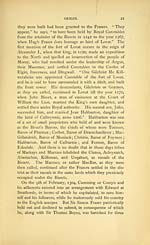History of the Frasers of Lovat
(40) Page 20
Download files
Complete book:
Individual page:
Thumbnail gallery: Grid view | List view

20 HISTORY OF THE FRASERS.
discoveries confirm, Wallace had gone to France to secure
the friendship of King- Philip.
Incensed at the successful opposition to his arms at
Roslin, Edward, on the 25th of February, 1303, at the
head of a large army crossed the Border, and entered
Scotland in the following - May, having reached Roxburgh
on the 17th of that month, Edinburgh on the 4th of
June; crossed the Spey on the 25th of July and lay "at
the manor of Rapenach " in Moray ; at Elgin on the 26th ;
at Rothes, on the 29th, from which he sent Sir John de
Cantelow and Sir John Hastings "to search the district
of Badenagh"; and at Kildrummie Castle, in Mar, on
his way south on the 31st of July, where he remained
until the 1st of August following.* His army, with his
principal officers at its head however carried the war into
the north Highlands, where they reduced the Castles of
Urquhart in Glenurquhart, and Dounie in the Aird. To
reduce Castle Dounie, it was necessary as in the case of
Urquhart, to lay "a regular siege, and, by throwing stones
by capultas, from trenches still to be seen at 700 yards
distance," by which means it was taken, demolished, and
dismantled. " The remains of the Dune or Celtic forti-
fication are still visible, and all its ditches and covered
ways exhibit a curious specimen of ancient fortification.
The country people have a romantic tradition of it, handed
down from father to son, and the names of some places
about preserve the memory of its surrender ; as for instance,
the hollow to the east of Beaufort, where the army halted,
is called in the language of the country, Lagnaloncart,
that is the 'hollow of the baggage.' "f This is quoted by
Anderson, who adds that Beaufort as well as its subsidiary
fortalice of Lovat, were at that time forts belonging to the
Crown, of which the Fentons and Grahams were governors,
and continued to be so even after the Bisset lands on which
* Journal of the movements of King Edward in Scotland, given at length
in the original French, wiih an English translation in the Historical Done
ments Relating to Scotland, Vol. II. pp. 25 to 32.
f MS. in the Advocates' Library. $1* . 6- f ■ *
discoveries confirm, Wallace had gone to France to secure
the friendship of King- Philip.
Incensed at the successful opposition to his arms at
Roslin, Edward, on the 25th of February, 1303, at the
head of a large army crossed the Border, and entered
Scotland in the following - May, having reached Roxburgh
on the 17th of that month, Edinburgh on the 4th of
June; crossed the Spey on the 25th of July and lay "at
the manor of Rapenach " in Moray ; at Elgin on the 26th ;
at Rothes, on the 29th, from which he sent Sir John de
Cantelow and Sir John Hastings "to search the district
of Badenagh"; and at Kildrummie Castle, in Mar, on
his way south on the 31st of July, where he remained
until the 1st of August following.* His army, with his
principal officers at its head however carried the war into
the north Highlands, where they reduced the Castles of
Urquhart in Glenurquhart, and Dounie in the Aird. To
reduce Castle Dounie, it was necessary as in the case of
Urquhart, to lay "a regular siege, and, by throwing stones
by capultas, from trenches still to be seen at 700 yards
distance," by which means it was taken, demolished, and
dismantled. " The remains of the Dune or Celtic forti-
fication are still visible, and all its ditches and covered
ways exhibit a curious specimen of ancient fortification.
The country people have a romantic tradition of it, handed
down from father to son, and the names of some places
about preserve the memory of its surrender ; as for instance,
the hollow to the east of Beaufort, where the army halted,
is called in the language of the country, Lagnaloncart,
that is the 'hollow of the baggage.' "f This is quoted by
Anderson, who adds that Beaufort as well as its subsidiary
fortalice of Lovat, were at that time forts belonging to the
Crown, of which the Fentons and Grahams were governors,
and continued to be so even after the Bisset lands on which
* Journal of the movements of King Edward in Scotland, given at length
in the original French, wiih an English translation in the Historical Done
ments Relating to Scotland, Vol. II. pp. 25 to 32.
f MS. in the Advocates' Library. $1* . 6- f ■ *
Set display mode to:
![]() Universal Viewer |
Universal Viewer | ![]() Mirador |
Large image | Transcription
Mirador |
Large image | Transcription
Images and transcriptions on this page, including medium image downloads, may be used under the Creative Commons Attribution 4.0 International Licence unless otherwise stated. ![]()
| Histories of Scottish families > History of the Frasers of Lovat > (40) Page 20 |
|---|
| Permanent URL | https://digital.nls.uk/96579672 |
|---|
| Description | A selection of almost 400 printed items relating to the history of Scottish families, mostly dating from the 19th and early 20th centuries. Includes memoirs, genealogies and clan histories, with a few produced by emigrant families. The earliest family history goes back to AD 916. |
|---|

